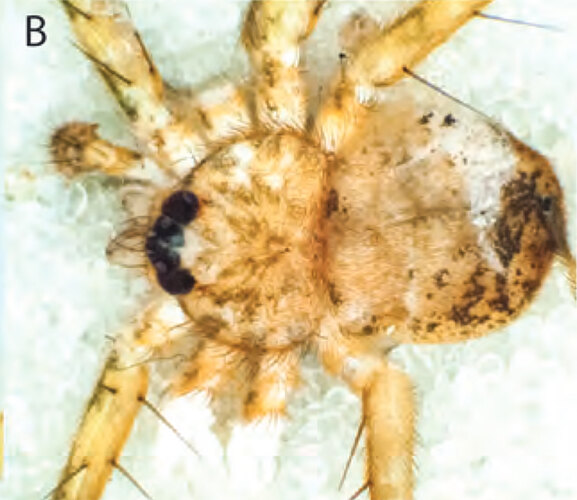Nyangumarta Flattie Karaops nyangumarta Crews, 2013
Fauna Portal species: 8947Diagnosis
(after Crews 2023): Karaops nyangumarta can be differentiated by the two oblong depressions toward the posterior where the copulatory openings are located on the epigyne. The endogyne differs by having fully sclerotized copulatory ducts, the copulatory ducts fold back on themselves rather than out to the sides, the ducts are narrow and short, the accessory bulbs are quite large and oval (erroneously labeled as spermathecae in Crews (2013)) and do not extend anteriorly of the spermathecae. The diagnosis of the male has been emended because of its similarity to the previously undescribed male of Karaops banyjima. Both K. banyjima and K. nyangumarta have a very large tegular lobe, but they can be easily separated by the median apophysis. In K. nyangumarta, there are many small spinules at the base, whereas there are none in K. banyjima.
Status
- native
Linnean Holotype
Australia
- Western Australia
Fauna Portal Records
The map shows all records that have been verified as part of the Fauna Portal project and may not represent the true distribution of a species. Specifically, for described species, check the link to the Atlas of Living Australia on this page for potential wider distributions. Fauna Portal Reference specimens and Linnean types are shown in red. If you identified a specimen that exceeds the distribution of an undescribed species as illustrated here, please contact the Fauna Portal team who can assist with the lodgement of the specimen in a public institution and display on the map.
Publications
Crews S.C. (2013): Thirteen new species of the spider genus Karaops (Araneae: Selenopidae) from Western Australia. Zootaxa. 3647: 443 - 469
Crews SC (2023): But wait, there’s more! Descriptions of new species and undescribed sexes of flattie spiders (Araneae, Selenopidae, Karaops) from Australia. ZooKeys. 1150: 1 - 189WEB
ACTTTATATTTGATTTTTGGAGCGTGATCTGCTATGGTAGGAACGGCTATAAGAGTTTTAATTCGGATGGAGTTAGGTCAGACGGGTAGATTTTTAGGAGATGATCATATATATAATGTTATTGTTACTGCACATGCTTTTGTTATAATTTTTTTTATAGTAATGCCTATTTTGATTGGGGGTTTTGGAAATTGATTAATTCCTTTAATATTGGGGGCGCCAGATATGGCTTTTCCTCGTATGAATAATTTGAGTTTTTGGTTATTACCTCCTTCTTTAATATTATTATTTATTTCGTCAATGGTAGAGATAGGGGTTGGTGCAGGATGAACGGTATATCCCCCTTTAGCAAGAGTTATAGGGCATGCTGGTAGTGCTGTTGATTTTGCAATTTTTTCTTTGCATTTGGCTGGTGCATCTTCTATTATGGGGGCTGTAAATTTTATTTCTACTGTAATTAATATACGTTCTGTGGGTATGTCAATGGAAAGGGTTCCTTTGTTTGTATGGTCTGTTTTTATTACGGCTATTTTATTATTATTGTCATTGCCAGTTTTAGCTGGGGCTATTACTATGTTATTAACTGATCGAAATTTTAATACTTCTTTCTTTGATCCTGCTGGAGGAGGTGATCCGATTTTATTTCAACATTTATT
CATAAAGATATTGGAACTTTATATTTGATTTTTGGAGCGTGATCTGCTATGGTGGGAACGGCTATAAGAGTTTTAATTCGGATGGAGTTAGGTCAGACTGGTAGATTTTTAGGAGATGATCACATATATAATGTTATTGTTACTGCACATGCTTTTGTTATAATTTTTTTTATAGTAATGCCTATTTTGATTGGGGGTTTTGGAAATTGATTAATTCCTTTAATATTGGGGGCGCCAGATATGGCTTTTCCTCGTATGAATAATTTGAGTTTTTGGTTATTACCTCCTTCTTTAATATTATTATTTATTTCATCAATGGTAGAAATAGGGGTTGGTGCAGGATGAACGGTGTATCCTCCTTTAGCAAGAGTTATAGGACATGCTGGTAGTGCTGTTGATTTTGCAATTTTTTCTTTGCATTTGGCTGGTGCATCTTCTATTATGGGGGCTGTAAATTTTATTTCTACTGTAATTAATATACGTTCTGTGGGTATGTCAATGGAAAGGGTTCCTTTATTTGTATGGTCTGTTTTTATTACGGCTATTTTATTGCTATTGTCATTGCCGGTTTTAGCTGGGGCTATTACTATGCTATTAACTGATCGAAATTTTAATACTTCTTTCTTTGATCCTGCTGGAGGAGGTGATCCGATTTTATTTCAACATTTATTTTGATTTTTTGGTCAC
CATAAAGATATTGGAACTTTATATTTGATTTTTGGAGCGTGATCTGCTATGGTGGGAACGGCTATAAGAGTTTTAATTCGGATGGAGTTAGGTCAGACTGGTAGATTTTTAGGAGATGATCACATATATAATGTTATTGTTACTGCACATGCTTTTGTTATAATTTTTTTTATAGTAATGCCTATTTTGATTGGGGGTTTTGGAAATTGATTAATTCCTTTAATATTGGGGGCGCCAGATATGGCTTTTCCTCGTATGAATAATTTGAGTTTTTGGTTATTACCTCCTTCTTTAATATTATTATTTATTTCATCAATGGTAGAAATAGGGGTTGGTGCAGGATGAACGGTGTATCCTCCTTTAGCAAGAGTTATAGGGCATGCTGGTAGTGCTGTTGATTTTGCAATTTTTTCTTTGCATTTGGCTGGTGCATCTTCTATTATGGGGGCTGTAAATTTTATTTCTACTGTAATTAATATACGTTCTGTGGGTATGTCAATGGAAAGGGTTCCTTTATTTGTATGGTCTGTTTTTATTACGGCTATTTTATTGCTATTGTCATTGCCGGTTTTAGCTGGGGCTATTACTATGCTATTAACTGATCGAAATTTTAATACTTCTTTCTTTGATCCTGCTGGAGGAGGTGATCCGATTTTATTTCAACATTTATTTTGATTTTTTGGTCAC
CATAAAGATATTGGAACTTTATATTTGATTTTTGGAGCGTGATCTGCTATGGTGGGAACGGCTATAAGAGTTTTAATTCGGATGGAGTTAGGTCAGACTGGTAGATTTTTAGGAGATGATCACATATATAATGTTATTGTTACTGCACATGCTTTTGTTATAATTTTTTTTATAGTAATGCCTATTTTGATTGGGGGTTTTGGAAATTGATTAATTCCTTTAATATTGGGGGCACCAGATATGGCTTTTCCTCGTATGAATAATTTGAGTTTTTGGTTATTACCTCCTTCTTTAATATTATTATTTATTTCATCAATGGTAGAAATAGGGGTTGGTGCAGGATGAACGGTGTATCCTCCTTTAGCAAGAGTTATAGGGCATGCTGGTAGTGCTGTTGATTTTGCAATTTTTTCTTTGCATTTGGCTGGTGCATCTTCTATTATGGGGGCTGTAAATTTTATTTCTACTGTAATTAATATACGTTCTGTGGGTATGTCAATGGAAAGGGTTCCTTTATTTGTATGGTCTGTTTTTATTACGGCTATTTTATTGCTATTGTCATTGCCGGTTTTAGCTGGGGCTATTACTATGCTATTAACTGATCGAAATTTTAATACTTCTTTCTTTGATCCTGCTGGAGGAGGTGATCCGATTTTATTTCAACATTTATTTTGATTTTTTGGTCAC
CATAAAGATATTGGAACTTTATATTTGATTTTTGGAGCGTGATCTGCTATAGTGGGAACGGCTATAAGAGTTTTAATTCGGATGGAGTTAGGTCAGACTGGTAGATTTTTAGGAGATGATCACATATATAATGTTATTGTTACTGCACATGCTTTTGTTATAATTTTTTTTATAGTAATGCCTATTTTGATTGGGGGTTTTGGAAATTGGTTAATTCCTTTAATATTGGGGGCGCCAGATATGGCTTTTCCTCGTATGAATAATTTGAGTTTTTGGTTATTACCTCCTTCTTTAATATTATTATTTATTTCATCAATGGTAGAAATAGGGGTTGGTGCAGGATGAACGGTGTATCCTCCTTTAGCAAGAGTTATAGGGCATGCTGGTAGKGCTGTTGATTTTGCAATTTTTTCTTTGCATTTGGCTGGTGCATCTTCTATTATGGGGGCTGTAAATTTTATTTCTACTGTAATTAATATACGTTCTGTGGGTATGTCAATGGAAAGGGTTCCTTTATTTGTATGGTCTGTTTTTATTACGGCTATTTTATTACTATTGTCATTGCCGGTTTTAGCTGGGGCTATTACTATGTTATTAACTGATCGAAATTTTAATACTTCTTTCTTTGATCCTGCTGGAGGAGGTGATCCGATTTTATTTCAACATTTATTTTGATTTTTTGGTCAC
Araneae (Spiders)
- Actinopodidae
- Anamidae
- Araneae fam. indet.
- Araneidae
- Archaeidae
- Argyronetidae
- Arkyidae
- Barychelidae
- Cheiracanthiidae
- Clubionidae
- Corinnidae
- Cycloctenidae
- Deinopidae
- Desidae
- Dictynidae
- Filistatidae
- Gnaphosidae
- Halonoproctidae
- Hersiliidae
- Idiopidae
- Lamponidae
- Linyphiidae
- Lycosidae
- Mimetidae
- Miturgidae
- Mysmenidae
- Nicodamidae
- Oecobiidae
- Oonopidae
- Oxyopidae
- Philodromidae
- Pholcidae
- Pisauridae
- Prodidomidae
- Salticidae
- Scytodidae
- Segestriidae
- Selenopidae
- Sparassidae
- Symphytognathidae
- Tetrablemmidae
- Tetragnathidae
- Theridiidae
- Thomisidae
- Trachelidae
- Trachycosmidae
- Trochanteriidae
- Uloboridae
- Zodariidae
- Zoropsidae
All classes
- Arachnida
- Crustacea
- Entognatha
- Gastropoda
- Insecta
- Orthoptera - Caelifera (Grasshoppers)
- Hymenoptera excl. Formicidae (bees and wasps)
- Blattodea s. str. (Cockroaches)
- Coleoptera (Beetles)
- Dermaptera (earwigs)
- Diptera (flies, mosquitos)
- Entomobryomorpha (slender springtails)
- Hemiptera - Heteroptera (True Bugs)
- Hemiptera - Sternorrhyncha (aphids, scales etc.)
- Hemiptera - Auchenorrhyncha (cicadas, planthoppers)
- Hymenoptera - Formicidae (Ants)
- Trichoptera (Caddisflies)
- Zygentoma (silverfish)
- Myriapoda

